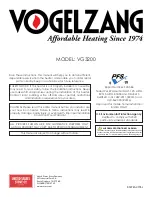
E & OE Instructions Part number IN1244
7
©
EUROHEAT
DISTRIBUTORS (H.B.S) LTD. May 2012
Choice Of Logs
Never burn wood that is not dry or wood that has been subject to a manufacturing process, such as chipboard,
as these contain resins of uncertain toxicity when burned. For the same reasons, wood that has been painted or
treated with a preservative should never be burned.
Natural wood is described as being either “hardwood” or “softwood”. Typically all broad leaf trees that lose their
leaves in the winter are called hardwoods, and the evergreen conifers are called softwoods. Whilst the wood
from the two groups have structural differences
,
the terms do not define the density or hardness of the wood.
Balsa, one of the softest and lightest of woods is classified as being a hardwood and Hemlock, a soft wood, is
extremely hard.
The less density wood has, the more its structure is made up of open spaces meaning it will season faster and
because of these voids it will burn faster because it will expose more surface area as it disintegrates. This makes
light woods suitable for kindling or a rapidly developing fire but unless you enjoy putting wood onto a fire every
few minutes it is unsuitable for burning over long periods. Although there is a difference in the speed at which
woods burn, equal weights of wood will give very similar amounts of heat.
Because logs are concentric tubes of cells they season faster if they are split, halving the tubes and allowing the
moisture to evaporate more easily. Similarly it also allows the volatile gases given off when the wood is heated
in a stove to be emitted along its full length rather than at the log’s ends. This helps the gases to be distributed
more evenly within the stove and improves not only the efficiency, and emission reduction of wood burning but
gives a more attractive fire.
Putting logs onto the fire, bark side down and laying them, well spaced, in random orientation, rather than
uniformly horizontally, will also help to increase the efficiency and attractiveness of the fire. To make this easier
the ideal log length will be the length the stove’s combustion chamber can accommodate in all directions, and
of proportionate cross-section, to allow you to load wood in a “higgledy-piggledy” manner.
DO NOT BURN
Anything but dry, natural wood. Wood that has been painted, treated or has hinges, nails or any plastic
attached will almost certainly emit toxic matter when burned. For similar reasons bonded wood products such
as chipboard, plywood or fibre board must never be burned.
DO NOT BURN
Household waste. Many seemingly innocuous items like box packaging have been coated with glazes
which will produce toxic matter when burned. One old video tape put on the fire will cause more
pollution in a few minutes than a life time of wood burning. Not only will a fire burning rubbish
pollute, the stove is not designed to contain such an assortment of sizes and weights and a flaming
box falling from the stove when the door is opened will present an unacceptable fire hazard.








































